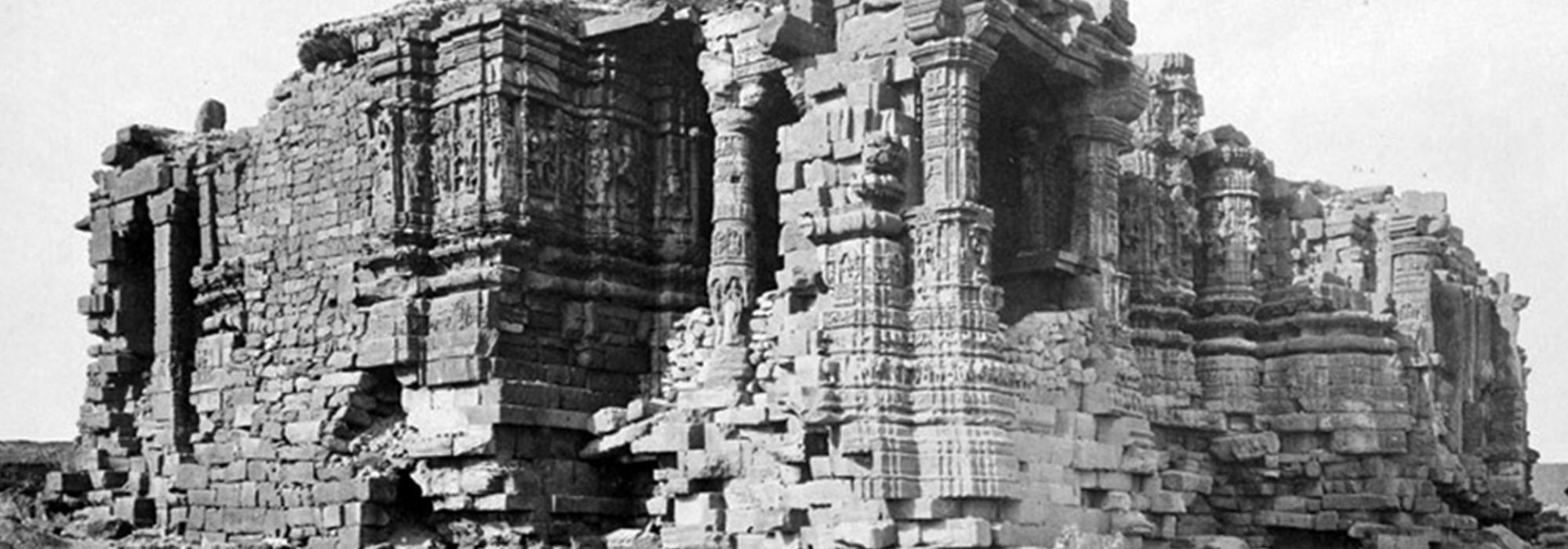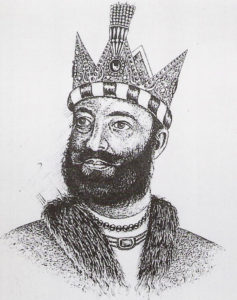Somnath is an ancient city on the West coast of India. Somnath has a history of at least 1,500 years that is well documented and there have been many references to this port city in the Mahabharata and the Puranas. The story of Somnath has to be looked at from different perspectives for the city has contributed to various different aspects of Indian life, most importantly to the soul of Indian civilizational values.
References in the Mahabharatas and the Puranas
Somnath derives its name from the mythological story where Chandra, the moon, worshiped Shiva at this place to get cured of the curse that Daksha (Chandra's father-in-law) had decried on him. Since Chandra worshiped Shiva here, Shiva gets the name Somnath, which means 'lord of the moon.' The Mahabharata describes Somnath as a city south of the confluence of River Sarasvati to the sea. Somnath is host to one of the twelve jyotirlingas. Krishna met his end in a place called Veraval, which is near Somnath. Arjuna is said to have performed the last rites of Krishna at the confluence of rivers Kapila and Hiranya.
[contextly_sidebar id="78hfMZOGrsyssfVkk3cJEyht7vbw4QvO"]
Somnath as a financial hub
Being a port city, it was an important center for economic activity and was known to have a well-organized port, which connected to West Asia and Africa. The Chinese traveler to India Hiuen Tsang, is known to have visited Saurashtra area between 641 and 644 CE. According to Tsang’s observation, Somnath was a thickly populated city that had huge establishments of religious and economic activities. Dandin’s Dashakumaracharita, which was written around the middle of 7th century CE, mentions a prosperous trader from Somnath, who had well-equipped ships to assist his trade. The Arab writer Jaun-ul-Akbar of 11th century CE says while describing Somnath, "On the coast of Hindustan lies a big city named Sammath, It is as important to Hindus as is Mecca to Muslims." The 13th century CE traveler Marco Polo has noted Somnath as a huge center for trade and religious activity.
History of the temple till 1000 CE
The temple has been destroyed and re-built multiple times over the last 1,300 years. The popular belief was that the first temple existed at Somnath at the start of the Common Era. Since 8th century CE, the temple has been a target for invading armies for 1,000 years. Below are the notable events till the end of the first millennium:
- The first temple was believed to have existed at the start of the Common Era. This temple is supposed to have been built by wood/bamboo.
- Around 649 CE the Maitrika kings of Vallabhi Gujarat, re-built the worn out centuries old temple.
- In 724 CE, Junayad was appointed as the governor of Sindh region. In 725 CE Junayad marched along with his army towards Marwar, Barauch, Ujjaini, and Malwa. He defeated the armies of Vallabhi. Merutunga’s work Prabandha Chintamani, a early 14th century CE work mentions the fall of Vallabhi into hands of invading Arab armies. The first major damage to Somnath temple happened during this time. The temple was renovated by Chalukya rulers of South Gujarat after the Arab armies receded.
- Nagabhatta II of Pratihara Dynasty was ruling over Kanauj during 815 CE. He worshiped Shiva at Somnath during his journey in Gurjara. Nagabhatta II expanded the Somnath temple into a huge complex built of red-sand stone.
- Graharipu had become the default ruler of Gujarat after the fall of Pratihara dynasty and Chalukyas in Gurjara. In 942 CE, Mularaja, commander of a small area called 'Sarasvatamandala' defeated Graharipu and captured Anhilawada (Patan). Hemachandra, the Jain poet who lived about a century after this period refers to Mularaja as the 'Architect of Gurjara.' There is also a legend which points to Mularaja as a descendant of Chalukyas. Mularaja was a devotee of Shiva and during his reign the Somnath temple is known to have gained prominence. Mularaja defeated Sapadalaksha, the ruler of Kutch, and ruled over most of what is present day Gujarat for about fifty years till his death in 996 CE. The rule of Mularaja and the prosperity of his kingdom are also mentioned in other literary works of that period like Kirtikaumudi, Vasanatavilasa, and Sukrtasankirtana. The Somnath temple had undoubtedly become rich and prosperous by the turn of the millennium.
Mahmud Ghazni’s entry into India
In 997 CE, in the Ghazni kingdom (in present day Pakistan-Afghanistan Border), the death of ruler Sebüktegīn triggered a war of succession between his sons. Mahmud who was known as a great fighter defeated his elder brother Ismail, sent him out of the kingdom, and became the undisputed ruler of areas to the west of River Sindhu and expanded his kingdom westwards till present day Iraq. Mahmud was very ambitious and wanted to attack and rule India. In 1000 CE, he crossed River Sindhu. The barbarity of the onslaught of Mahmud caught the Indian rulers totally unprepared. Battles in India till that time used to happen for establishing military might and becoming an emperor. Indian rulers were now facing up to a ruthless aggressor who wanted to kill people and rob the wealth. This ill-preparedness of Indian rulers laid the foundations for suffering under foreign rule for the next 1,000 years.
Mahmud Ghazni’s first hurdle
Shahi King Jayapala lost the decisive battle to Mahmud in 1001 CE on the eastern bank of Sindhu. (Jayapala had lost his territories on the western bank of Sindhu in 990 CE to Mahmud’s father.) After losing the battle, Jayapala entered into fire and died. His son Anandapala took charge of the kingdom while acting as a subordinate to Mahmud. Anandapala built a reasonable army and challenged Mahmud in 1004 CE but he was badly defeated and the kingdom was plundered. Anandapala fled to Kashmir. Mahmud was under constant threat from the eastern banks of Sindhu and faced a western threat from Ilaq Khan. At this juncture, Anandapala committed a monumental blunder by offering to help Mahmud to fight the western threat. Anandapala sent a message to Mahmud saying, "You have won me and my kingdom. I can’t see you being attacked." The combined forces of Shahis and Ghaznis defeated Ilaq Khan. In a pleasant gesture of returning the favor, Mahmud attacked Shahis in 1008 CE. Ghazni comprehensively captured northern Sindh and Punjab regions. Anandapala continued to look after regions around Lahore. Anandapala died in 1012, paving way for his son Trilochanapala to succeed him. Mahmud attacked Trilochanapala immediately after Anandapala’s death. Trilochanapala fought valiantly and took control but finally lost the war. Many historians have described that Trilochana (the three-eyed one) in battle looked like Shiva himself out to destroy the enemies. Though Trilochanapala in exile put up some resistance for some time, it didn’t cause any harm to Mahmud or his army.
Loot of wealth from India
Mahmud attacked Nagarkot in 1009 and Thaneshwar in 1011. After the end of Trilochanapala, Mahmud was unchallenged till the western banks of Yamuna. In 1018, he crossed Yamuna and attacked Kanauj. He plundered huge amounts of wealth from Kanuaj. Between 1019 and 1022 CE Mahmud faced stiff resistance from Vidyadhara, the Chandela king. There was no decisive outcome of these wars and Mahmud retreated back to Punjab. Even during all these wars, Mahmud looted temples and collected huge amount of wealth.
Mahmud turns towards the South
In October 1025 CE, Mahmud started from Ghazni with full-fledged preparations. His army consisted of 30,000 horses; 30,000 camels to negotiate the desert and carry water; and hundreds of thousands of foot soldiers. Towards the end of November, he rested in Multan and entered the desert. He advanced southwards and took control of Ludhrava valley. He reached Anhilawada (Patan) by end of December and rested there for some time. Bhimdeva of the Solanki dynasty, who was a subordinate to Raja Bhoja of Ujjaini faced up to Mahmud at Modhera, but lost. The kings of Gurjara started to unite under the leadership of Bhoja. Sensing this political development, Mahmud proceeded straight towards Somnath without unnecessarily provoking local rulers. According to Muslim historians Mahmud reached Somnath on 6 January 1026. Mahmud surrounded the city of Somnath. The local ruler of Somnath fought for eight days and kept the invading armies out of the city. Finally the local army succumbed and this gave way to the first destruction of Somnath temple. The temple was completely razed down. (Some remains of the temple built by Nagabhatta II and demolished by Mahmud was seen in the lower segments of the site of the shrine during the survey in 1947-48.) He broke the shivalinga into two pieces and killed thousands of unarmed devotees who came forward to protect the temple. Mahmud’s joy was short lived as he stared up to an alliance under the leadership of Bhoja, and started to move back towards his kingdom. The army of the alliance chased Mahmud till Sindh. Alberuni records the arrival of Mahmud's army to Multan in April 1026. Some of the soldiers of Mahmud's army were taken as prisoners, but they were pardoned and allowed to live as normal citizens.
















































